Click on images to enlarge
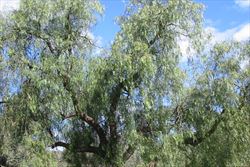
habit (Photo: Sheldon Navie)
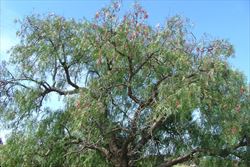
habit in fruit (Photo: Sheldon Navie)
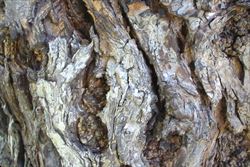
close-up of rough bark on main trunk (Photo: Sheldon Navie)
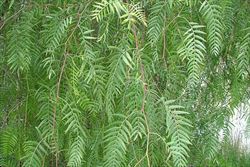
drooping younger branches and leaves (Photo: Sheldon Navie)
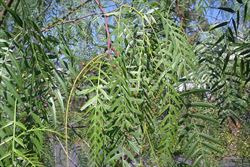
once-compound leaves with several elongated leaflets (Photo: Sheldon Navie)
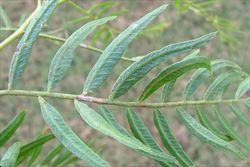
close-up of elongated leaflets (Photo: Sheldon Navie)
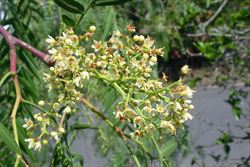
flower cluster (Photo: Sheldon Navie)

immature fruit (Photo: Sheldon Navie)
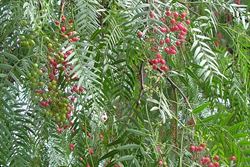
clusters of mature fruit (Photo: Sheldon Navie)

close-up of mature fruit (Photo: Sheldon Navie)
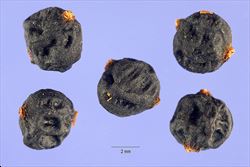
close-up of seeds (Photo: Steve Hurst at USDA PLANTS Database)
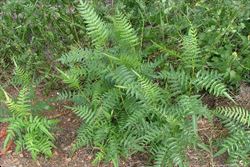
root suckers (Photo: Sheldon Navie)
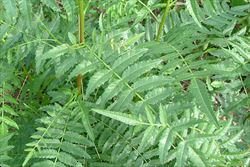
close-up of the toothed leaves on a younger plant (Photo: Sheldon Navie)
Scientific Name
Schinus molle L. var areira (L.) DC.
Synonyms
Schinus molle L.Schinus areira L.
Family
Anacardiaceae
Common Names
California peppertree, Californian pepper tree, Californian peppertree, pepper tree, peppercorn, peppercorn tree, pepperina, pepper-tree, peppertree, Peruvian mastic, Peruvian mastic tree, Peruvian mastictree, Peruvian pepper tree, Peruvian peppertree
Origin
Native to South America (i.e. Brazil, Bolivia, Ecuador, Peru, Argentina, northern Chile, Paraguay and Uruguay).
Cultivation
This introduced species is widely grown as a garden and street tree (i.e. ornamental) in Australia.
Naturalised Distribution
Widely naturalised in southern and eastern Australia. Common and widespread in eastern New South Wales, Victoria, south-eastern South Australia and southern Western Australia. Also occasionally naturalised in south-eastern and central Queensland, in other parts of South Australia and in the southern parts of the Northern Territory.
Naturalised overseas in tropical and southern Africa, temperate Asia, New Zealand, southern USA (i.e. California, Texas and Florida) and on some Pacific islands (i.e. Hawaii and the Galapagos Island).
Habitat
A weed of waterways (i.e. riparian areas), open woodlands, grasslands, roadsides, waste areas, disturbed sites and coastal environs in temperate and semi-arid regions. Occasionally also found in some habitats in sub-tropical and arid regions.
Habit
An upright (i.e. erect) tree growing up to 10 m tall, with drooping younger branches.
Distinguishing Features
- an upright tree with drooping younger branches that grows up to 10 m tall.
- its alternately arranged leaves (12-25 cm long) are once-compound and have numerous leaflets.
- the long and narrow leaflets (15-50 mm long and 2-10 mm wide) are mostly hairless with entire margins and pointed tips.
- its small white flowers are arranged in drooping branched clusters.
- its fruit resemble small berries (3-6 mm across) and turn red or bluish-pink as they mature.
Stems and Leaves
The alternately arranged leaves (12-25 cm long) are borne on stalks (i.e. petioles) 2-5 cm long. They are once-compound (i.e. pinnate) and have numerous (17-35) leaflets. Each leaflet is elongated in shape (i.e. lanceolate or linear) and is either stalkless (i.e. sessile) or borne on a very short stalk (i.e. petiolule) 0-1 mm long. These leaflets (15-50 mm long and 2-10 mm wide) are mostly hairless (i.e. glabrous) with entire margins and pointed tips (i.e. acute apices).
Flowers and Fruit
The small white flowers are arranged in drooping branched clusters (i.e. panicles). Each flower is borne on a short stalk (i.e. pedicel) 1-2 mm long and has five tiny sepals (about 1 mm long) and five small petals (about 2 mm long). Separate male and female flowers are present in these clusters. The male flowers have ten stamens, while the female flowers have reduced stamens (i.e. staminodes) and an ovary topped with a style and stigma.
The fruit resemble small berries (i.e. they are drupes) and turn from green to red or bluish-pink in colour as they mature. They are rounded (i.e. globose) in shape, 3-6 mm across, and the skin becomes papery when fully mature.
Reproduction and Dispersal
This species reproduces mainly by seed, but also spreads vegetatively by suckering.
The seeds are dispersed by birds and other animals that eat the fruit.
Environmental Impact
Pepper tree (Schinus molle var. areira) is regarded as an environmental weed in Victoria, New South Wales, South Australia and the Northern Territory. It was recently listed as a priority environmental weed in five Natural Resource Management regions.
Legislation
Not declared or considered noxious by any state government authorities.
Similar Species
Pepper tree (Schinus molle var. areira) may sometimes be confused with broad-leaved pepper tree (Schinus terebinthifolius). These two species can be distinguished by the following differences:
- pepper tree (Schinus molle var. areira) has drooping (i.e. pendulous) leaves with very narrow leaflets (2-10 mm across).
- broad-leaved pepper tree (Schinus terebinthifolius) has spreading leaves with relatively broad leaflets (12-30 mm across).

